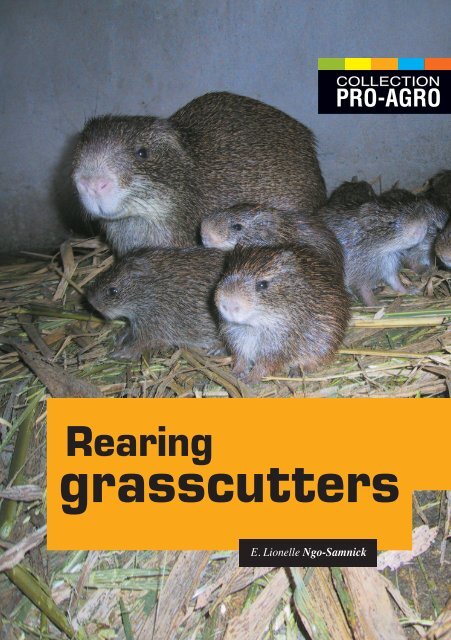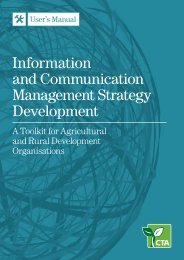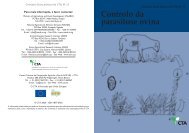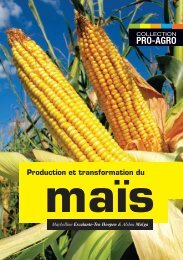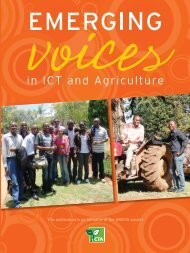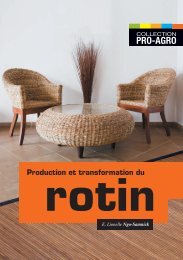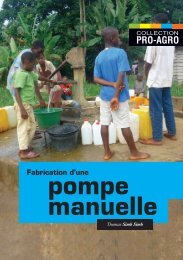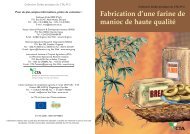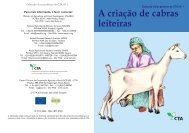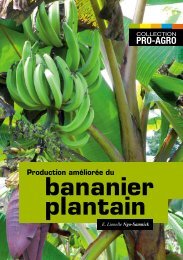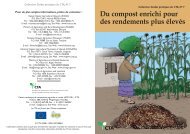Rearing grasscutters - CTA Publishing
Rearing grasscutters - CTA Publishing
Rearing grasscutters - CTA Publishing
Create successful ePaper yourself
Turn your PDF publications into a flip-book with our unique Google optimized e-Paper software.
PRO-AGRO<br />
<strong>Rearing</strong><br />
<strong>grasscutters</strong>
Intervenants<br />
ContRibutoRs<br />
E. Lionelle Ngo-Samnick<br />
Review<br />
Kokou Edoh Adabe and Pascal Nondjock<br />
illustRations<br />
Eric Mengaptche and Beatriz Garcia<br />
layout<br />
Stéphanie Leroy<br />
The Pro-Agro Collection is a joint publication by Engineers Without Borders,<br />
Cameroon (ISF Cameroun) and The Technical Centre for Agricultural and Rural<br />
Co-operation (<strong>CTA</strong>).<br />
<strong>CTA</strong> – P.O. Box 380 – 6700 AJ Wageningen – The Netherlands – www.cta.int<br />
ISF Cameroun – BP 7105 – Douala-Bassa – Cameroun – www.isf-cameroun.org<br />
© <strong>CTA</strong> and ISF 2012<br />
Cover: © G.A. Mensah, Bénin<br />
ISBN (<strong>CTA</strong>): 978-92-9081-491-7
Contents<br />
1<br />
Housing<br />
1.1 Conditions for breeding ............................................................. 5<br />
1.2 Materials for the rearing shed ............................................. 5<br />
1.3 Materials for the rearing pens ............................................. 6<br />
2<br />
Reproduction<br />
2.1 Basic facts ............................................................................................... 9<br />
2.2 Selection for breeding .................................................................... 9<br />
2.3 Mating ........................................................................................................ 10<br />
2.4 Gestation .................................................................................................... 10<br />
3<br />
Handling <strong>grasscutters</strong><br />
12<br />
4<br />
Feeding<br />
4.1 Dietary planning .............................................................................. 13<br />
4.2 Providing food, water and<br />
mineral supplements .................................................................... 15<br />
4.3 Conserving and stocking food ............................................. 15<br />
5 Production planning<br />
16<br />
6<br />
Disease management<br />
6.1 Preventative measures ................................................................ 17<br />
6.2 Some symptoms of sick <strong>grasscutters</strong> ............................ 18<br />
6.3 Veterinary treatment .................................................................... 19<br />
7<br />
Monitoring the farm<br />
7.1 Recordkeeping .................................................................................... 22<br />
7.2 Infrastructure maintenance ................................................... 24<br />
8<br />
Other information<br />
8.1 Financial planning ........................................................................... 25<br />
8.2 Useful contacts ................................................................................... 27
General<br />
information<br />
Grasscutters (Thryonomys swinderianus) are rodents widely found in grasslands,<br />
clearings, wet or marshy areas in Africa. They are more commonly known as<br />
“hedgehogs” in Central Africa, “agouti” in French-speaking West Africa, and<br />
“cane rats” in English-speaking West Africa.<br />
Although widely hunted, <strong>grasscutters</strong> can also be domesticated.<br />
They are placid animals and relatively prolific, becoming sexually<br />
mature and able to reproduce at around five to six months,<br />
and producing litters of up to twelve young. Because they are<br />
easy to rear, their production offers an alternative to poaching<br />
bushmeat. Grasscutters can grow quickly in intensive conditions,<br />
and their meat is high in protein and value.
1<br />
HOUSING<br />
1.1 Conditions for breeding<br />
in intensive production, <strong>grasscutters</strong> should be kept in cages or<br />
pens inside a secure shed. The location of the shed is critical for successful<br />
rearing.<br />
The area should be easily accessible, in a flood-free zone, removed from<br />
noise, well aired and ventilated, with feed and a water source, as well as<br />
being secure. The size of the building will depend on the number of <strong>grasscutters</strong><br />
kept and production objectives. By way of example, the space<br />
required for a group of reproductive <strong>grasscutters</strong> comprising one adult<br />
male and four females is 1.6 to 2 m 2 .<br />
1.2 Materials for the rearing shed<br />
Different types of material are used in the construction of the rearing<br />
shed, including bricks or breezeblocks, bamboo, straw and matting. The<br />
key is to use local materials in order to keep down construction costs.<br />
The building should be ventilated and offer enough light to facilitate rearing<br />
activities. The long sides of the structure are made of a low wall 1.5 m<br />
high, with the upper half covered with chicken wire. The roof can be made<br />
out of corrugated iron, straw or any other kind of waterproof material.<br />
5
1.3 Materials for the rearing pens<br />
<strong>Rearing</strong> pen<br />
The <strong>grasscutters</strong> are kept in pens inside the rearing shed. The number of<br />
pens depends on the production objectives. It is recommended to have one<br />
breeding female per pen. The recommended surface area per adult animal<br />
in the pen is 0.2 m 2 .<br />
one possible setup could include:<br />
• A pen for fattening young <strong>grasscutters</strong>;<br />
• A pen for adults;<br />
• A pen for mating;<br />
• A pen for giving birth and feeding the young.<br />
The layout of the pens depends on the type of material used in their<br />
construction. Metal pens can be moved around, whereas brick pens will<br />
be fixed.<br />
It is not recommended to use materials such as straw, bamboo, wood or<br />
matting because they can be eaten away by the <strong>grasscutters</strong>. The pens<br />
can be open or closed, whichever the producer prefers. There should be<br />
room to move around between the pens.<br />
4 m<br />
12 m<br />
An open pen<br />
6
open pens are enclosures without any covering on top, and with a surface<br />
area of about 3 m2 and 1.5 high. There is an opening in the side that gives<br />
onto the aisle in order to facilitate easy access for the farmer.<br />
Closed pens are covered by some kind of appropriate roofing material, and<br />
may be divided into compartments using partitions. The height of the wall is<br />
lower (80 cm) and the surface area can vary between 2 and 3 m 2 .<br />
If there are two compartments, they should have the same surface area.<br />
The compartments are separated with partitions, with a 15 cm opening to<br />
allow the free movement of the animals from one compartment to another.<br />
The covering can be made from various materials.<br />
1,5 m<br />
40 cm<br />
1,5 m<br />
Pens with partitions<br />
The floor inside the building should be smooth and even, while the pens can<br />
be plastered or not.<br />
Feeding and drinking troughs can be made of cement or clay, and should<br />
be heavy enough so that the <strong>grasscutters</strong> cannot knock them over. The<br />
producer can make the troughs himself. All that is needed is to make a<br />
mould out of wood or other scrap material. Calculate one trough per three<br />
<strong>grasscutters</strong>.<br />
7
7 cm<br />
6 cm<br />
How to make a trough<br />
The dimensions<br />
of the cage<br />
should be almost<br />
the same as the<br />
animal to be<br />
handled.<br />
The squeeze cage is used to handle the animals more easily. The dimensions<br />
of the cage should be almost the same as the animal to be handled.<br />
The producer can make it himself, by building a rectangular cage with fine<br />
meshed screening. The producer should base the size of the cage on the<br />
average weight of the animals in his production, and will also depend on<br />
the animal stock chosen (heavy or light variety). The squeeze cage should<br />
be built in such a way that the animal cannot turn around inside the cage.<br />
80 cm<br />
1 m<br />
2 m<br />
Squeeze cage for<br />
handling <strong>grasscutters</strong><br />
8
2<br />
REPRODUCTION<br />
2.1 Basic facts<br />
sexual maturity:<br />
• For the male: 8 months (32 weeks) at a minimum body weight of 2.5 kg;<br />
• For the female: 6.5 months (26 weeks) at a minimum body weight<br />
of 1.8 kg.<br />
sex ratio: 1 male for 4 to 10 females.<br />
Ovulation in the female is triggered by the presence of a male.<br />
Gestation period: 5 months (22 weeks) approximately<br />
number of litters per year: 2 litters<br />
number of young per litter: 4 young<br />
suckling period: 40 days (6 weeks) before weaning<br />
2.2 Selection for breeding<br />
selecting a group of animals for breeding should not be done at random.<br />
The farmer can get the best animals from the nearest breeding<br />
and multiplication centre, or from another breeder. The selection should<br />
be made on the basis of weight. The females should all have around the<br />
same weight (avoid weight differences of greater than 500 g); in contrast,<br />
the male should be 0.5 to 1 kg heavier than the females. Closely related<br />
mating pairs, where the male is related to the females, are also not<br />
recommended. The females can, however, be related.<br />
9
2.3 Mating<br />
the male grasscutter can mate with several females in a single period.<br />
The male, who can be identified by his wrinkled, brown genitals, is placed<br />
first in the pen so that he can mark his territory and thereby reduce the<br />
risk of fights. The female, identified by the closeness of the anus to the genital<br />
area, is put in the pen with the male for 24 hours. During the mating<br />
session, make sure the male is heavier than the female.<br />
There are generally two options for mating in captivity:<br />
Permanent mating: The male and females remain together in the same<br />
pen, and only the young are removed after weaning.<br />
temporary mating: The female is placed in the same pen as the male at<br />
a particular point in time, and removed once pregnant.<br />
Each of these options has pros and cons depending on production goals<br />
and the degree of organization in the breeding operation.<br />
a comparison of the advantages and disadvantages of the two types of mating<br />
Type<br />
of mating<br />
Advantages<br />
Disadvantages<br />
PeRmanent<br />
matinG<br />
temPoRaRy<br />
matinG<br />
Increased breeding<br />
cycle<br />
• Reduced risk of<br />
adult male killing<br />
offspring<br />
• Clear identification<br />
of mother and<br />
offspring<br />
• Excellent<br />
management of<br />
breeding process<br />
• Difficult to identify the mother of each offspring<br />
• Less control over reproduction<br />
• Risk of cannibalism<br />
• Under-exploitation of the male<br />
• Risk of exhausting reproductive females<br />
• Increased investment (several pens needed)<br />
• Need for larger space to house females<br />
• Reduced number of litters per female and per<br />
year<br />
2.4 Gestation<br />
Gestation is around five months. After mating, it is recommended to check<br />
that the female is pregnant by using a simple test.<br />
10
Pregnancy test<br />
Four to eight weeks after mating, take a swab sample from the female’s<br />
genitals by carefully inserting a cotton bud (for cleaning babies’ ears). If the<br />
swab does not discolour, then the female is not in gestation. In contrast, if<br />
the swab turns reddish brown, then the female is in gestation.<br />
Gestation test<br />
>>> birth<br />
Newborn <strong>grasscutters</strong>, even when very small, already resemble fully grown<br />
adults. They can move around easily within a few hours. After delivery, special<br />
measures should be taken to ensure that the mother gets sufficient,<br />
good quality food, and that she gets plenty of water, which is essential for<br />
effective milk production.<br />
>>> weaning <strong>grasscutters</strong><br />
Weaning generally takes place 40 days after birth, and should not be<br />
extended because the mother will grow weak from prolonged feeding of her<br />
young. During weaning, the young males are separated from the females<br />
and put together with other males of the same weight. The male can be<br />
identified by the distance between the genitals and the anus, which is twice<br />
as large as that of the young female.<br />
Identifying the female and male<br />
11
3<br />
HANDLING<br />
GRASSCUTTERS<br />
Handling <strong>grasscutters</strong> is not easy.<br />
The technique used depends on the size of the animal.<br />
a young, light animal is lifted by the tail by holding at the base of the tail.<br />
Then grab its back with the other hand (just behind the front legs and without<br />
squeezing too hard). The animal is thereby turned on its back, while<br />
holding the tail stretched out at the same time.<br />
a medium-sized animal can also be lifted by the tail, but it is recommended<br />
to grab it on the back with the other hand so that there is not too<br />
much weight on the tail, especially if the animal is agitated. The animal is<br />
then turned on its back in order to calm it down.<br />
a heavy animal should be handled by means of the squeeze cage.<br />
A young animal is lifted by holding at the base of the tail whilst<br />
grabbing its back with the other hand.<br />
12
4<br />
FEEDING<br />
the food supplied should meet all the animal’s daily requirements.<br />
In captivity, <strong>grasscutters</strong> can eat fresh or dried food, although their diet<br />
consists mainly of green forage. It can be supplemented by feed with high<br />
energy value, or added protein and minerals.<br />
4.1 Dietary planning<br />
The animals should get a balanced diet each day. A diet based solely on<br />
green forage will lead to slow growth and reduced milk production in feeding<br />
mothers, thereby increasing the risk of various infections.<br />
At the same time, insufficient forage can lead to digestive problems. It has<br />
been calculated that a complete and balanced diet will produce an average<br />
weight of 3.5 kg in males and 2.8 kg in females.<br />
Examples of food<br />
Arachide<br />
Riz<br />
Fausse canne<br />
(appelée Pennisetum)<br />
Blé ou son de blé<br />
Maïs<br />
Ananas,<br />
papaye verte<br />
Pain rassis<br />
13
some commonly used forage and concentrates<br />
annual grasses<br />
Perennial grasses<br />
legumes<br />
moringa<br />
agricultural by-products<br />
by-products from agricultural<br />
processing<br />
Roots and tubers<br />
Cereal grains<br />
shells<br />
other<br />
Type<br />
Andropogon gayanus, Brachiaria mutica<br />
Panicum maximum, Pennisetum purpureum,<br />
Tripsacum laxum<br />
Leucaena leucocephala, Gliricidia sepium,<br />
Stylosanthes guyanensis<br />
Moringa oleifera<br />
Name<br />
Garden waste, kitchen leftovers, dried sunflower<br />
heads and seeds, or pods from black-eyed<br />
peas<br />
Dry bread, corn or sorghum bran, groundnut and<br />
palm kernel cakes, wheat bran, brewers’ dried<br />
grain, broken rice at wheat grains<br />
Cassava, potato, yam or taro pellets, peels and<br />
scraps from cassava or other tubers<br />
Corn, sorghum, millet, rice<br />
Powdered oyster, snail or egg shells,<br />
with bone meal and cooking salt<br />
Ripe or unripe fruit, cores from the crowns of palm,<br />
coconut or pineapple trees or banana plants, the<br />
bark of certain trees, green papaya, the trunk of<br />
the papaya, bamboo shoots, leaves and tops from<br />
pineapples<br />
14
4.2 Providing food, water and mineral<br />
supplements<br />
The animals should have continual access to food.<br />
Fodder should be given two hours before giving concentrates, once or twice<br />
a day, preferably in the morning and evening.<br />
Water should always be available.<br />
Grassy fodder should be dried in the sun at least 24 hours before being<br />
given. Do not give damp fodder.<br />
Concentrate can be given by themselves or in combination with fodder.<br />
It can be made up from just one ingredient or several. If using singleingredient<br />
concentrates, make sure to alternate when you give them. In<br />
contrast, if the concentrate is a mix of two or three ingredients, then<br />
the same contrite can be given every time. Any changes in concentrates<br />
should be made over four to five days in order to allow the digestive system<br />
to adapt.<br />
Bones, shells and pieces of wood help to wear down the teeth. After burning,<br />
bones can be given in powder form, mixed in with the concentrate, and can<br />
provide a source of minerals, especially phosphorus and calcium.<br />
4.3 Conserving and stocking food<br />
>>> Fodder should be dried and then kept in a dry place. If fodder is scarce,<br />
then it may be worth considering planting more fodder for this purpose.<br />
>>> Concentrate is perishable and can be sensitive to changes in temperature,<br />
humidity, oxidation and subject to attack from mould, bacteria, fungi,<br />
insects, mites, rodents, birds, etc. Make sure appropriate measures are<br />
taken to ensure the best possible conservation.<br />
15
5<br />
PRODUCTION<br />
PLANNING<br />
Good planning means controlling the maximum number of animals in<br />
the shed. This figure should always be uppermost in any production planning,<br />
and litters should be calculated and planned throughout the year.<br />
The date of a positive gestation should therefore be recorded, so that the<br />
delivery date, around three and a half months later, can be planned in. The<br />
number of newborn <strong>grasscutters</strong> can also be calculated by multiplying the<br />
average number per litter by the number of females in gestation.<br />
A single pen<br />
can hold a<br />
maximum of<br />
15 young<br />
<strong>grasscutters</strong><br />
During weaning, the young males are separated from the young females.<br />
Given that a single pen can hold a maximum of 15 young <strong>grasscutters</strong>, it is<br />
possible to predict how many pens will be needed. The breeder should not<br />
hesitate to sell surplus animals or to enlarge pens as soon as possible, in<br />
order to reduce the risk of overpopulation.<br />
16
6<br />
DISEASE<br />
MANAGEMENT<br />
6.1 Preventative measures<br />
Daily inspection of the pens will allow early detection of sick animals. Basic<br />
hygiene measures and an appropriate diet will also reduce potential losses.<br />
Avoid unnecessary noise and handling as this could lead to accidents such<br />
as fractures of bones or of the tail.<br />
The key to good hygiene is disinfection, which includes the complete range<br />
of actions targeting micro-organisms that cause disease. Disinfection<br />
works against parasites as well as diseases.<br />
Wash the equipment (feeding and drinking troughs, etc.) at least once<br />
a week, and disinfect the pens and the shed each month. Keep the pen<br />
empty in between two occupations, and enforce systematic quarantine for<br />
all animals brought in from outside the farm.<br />
Make sure rat poison is always in place around the shed and in the food<br />
storage area. Give vitamins, sweetened lemon juice and mineral supplements<br />
every two weeks.<br />
sweetened lemon juice helps strengthen the immune system in <strong>grasscutters</strong>.<br />
It should be given each time the animals undergo stress. To make it,<br />
add 55 sugar lumps and two large glasses of pure lemon juice (or 400 ml)<br />
to 20 litres of water.<br />
17
Products to disinfect the buildings<br />
Product<br />
Application<br />
Household soap<br />
Dilute in water<br />
Bleach<br />
10% solution in water (100 ml in 1 l of water)<br />
Disinfectant detergent<br />
(for example, Crésyl)<br />
4% solution (40 ml in 1 l of water)<br />
Quicklime<br />
Dilute in water<br />
Bleach + detergent<br />
Dilute in water, using the guidelines for bleach<br />
and detergent, respectively.<br />
6.2 Some symptoms of sick <strong>grasscutters</strong><br />
The following symptoms may indicate the onset of illness: social withdrawal,<br />
inability to escape capture, matted or dull-looking fur, loss of appetite,<br />
abnormally long incisors, soft or liquid faeces, coughing, inflammation<br />
of a body part, paralysis, etc.<br />
If the symptoms persist, then contact a vet.<br />
18
overview of main problems and proposed solutions<br />
Symptoms Solution Additional actions<br />
animal prostrate,<br />
not moving much,<br />
lethargic<br />
Dull or matted fur<br />
newborns<br />
partially eaten<br />
by the females<br />
Death of suckling<br />
babies<br />
Food not eaten<br />
weight loss<br />
Dead animal<br />
• Separate the grasscutter<br />
• Do a thorough examination (teeth,<br />
abscesses, sores or cuts)<br />
• Give sweetened lemon juice. If nothing<br />
found, give antibiotics.<br />
• Check feed quantities and regularity of<br />
feeding<br />
• Check for dampness and cold<br />
• Check the correct mix in the group<br />
• Nothing to report if females are ending<br />
a period of lactation<br />
• Increase feed rations for gestating<br />
females (proteins and minerals)<br />
• Eradicate any rats or other harmful<br />
rodents (traps)<br />
• Prevent cold and draughts<br />
• Check feeding quantities<br />
• Check quantities given to milking females<br />
• Check feeding quantities<br />
• Check teeth for wear<br />
• Sweetened lemon juice<br />
• Destroy the carcass<br />
• Carefully record any deaths<br />
• Disinfect the pen<br />
• Observe any changes on a<br />
regular basis<br />
• Close any openings<br />
• Check the fur during the<br />
warmest periods of the day<br />
• Pay attention to repeated<br />
incidents if it occurs with a<br />
female’s first litter<br />
• Close off any openings with<br />
fine mesh<br />
• Transfer to a closed pen<br />
• Sweetened lemon juice<br />
• Disinfect the pen<br />
• If everything else appears<br />
OK, give long-acting antibiotics<br />
by injection or in powder<br />
form in the drinking water<br />
• Disinfect the pen<br />
• Deworm<br />
6.3 Veterinary treatment<br />
The breeder should dispose of a small pharmaceutical reserve as part<br />
of his basic setup. The basic components are cotton wool, antiseptic<br />
products (iodized alcohol and glycerine) antibiotics, anti-inflammatory and<br />
deworming drugs. Local plants can also be used, as long as their effects<br />
are understood.<br />
19
overview of main problems and proposed solutions<br />
Symptoms<br />
Illness and<br />
probable cause<br />
Solution<br />
Additional actions<br />
several dead<br />
animals<br />
Illness: Épidemic<br />
• Long-acting antibiotics in<br />
the drinking water of the<br />
whole colony<br />
• Incinerate or bury the<br />
carcass<br />
• Disinfect the farm<br />
completely<br />
• Check the feed quality<br />
• Seek veterinary advice<br />
• Laboratory tests<br />
several dead<br />
animals at the<br />
same time and<br />
in the same pen<br />
Illness: Suspected<br />
disease<br />
• Check the feed quality<br />
• Transfer the <strong>grasscutters</strong><br />
to a separate area for<br />
quarantine<br />
• Long-acting antibiotics for<br />
all the <strong>grasscutters</strong> in the<br />
pen<br />
• Disinfect the pen<br />
thoroughly<br />
• Standard disinfection<br />
of the rest of the shed<br />
and equipment<br />
Damaged skin,<br />
exposed muscle<br />
Illness: Wound<br />
• Antiseptic and antibiotic in<br />
powder form<br />
• Sweetened lemon juice<br />
• Check there are no<br />
sharp or jagged points<br />
in the pen or cage<br />
• Check there are no<br />
reasons for fighting<br />
(enough food, number<br />
of feeding troughs,<br />
homogenous group, for<br />
example)<br />
bulging at the<br />
base of the tail<br />
Illness: Tail<br />
detached during<br />
handling<br />
• Amputate the tail<br />
Treat the wound for five<br />
days after the amputation<br />
with antiseptic, powdered<br />
antibiotic used externally<br />
and long-acting antibiotic<br />
by injection or as a powder<br />
in the drinking water.<br />
Sweetened lemon juice<br />
lump under<br />
the skin<br />
Illness: Abscess<br />
• Puncture the abscess and<br />
empty it completely<br />
• Put antiseptic under the skin<br />
• Powdered antibiotic applied<br />
externally<br />
• Long-acting antibiotic by<br />
injection or as a powder in<br />
the drinking water<br />
• Check feed quality<br />
• Sweetened lemon<br />
juice<br />
• Disinfect the pen<br />
20
Symptoms<br />
Illness and<br />
probable cause<br />
Solution<br />
Additional actions<br />
soft or liquid<br />
stools<br />
Dirty anus<br />
Illness: Diarrhoea<br />
Probable cause:<br />
Poor quality feed,<br />
sudden change in<br />
concentrate<br />
• Antibiotic in the drinking<br />
water<br />
• Reintroduce fibre diet<br />
(forage)<br />
• Pay attention to feed quality<br />
Disinfect the pen<br />
Coughing, nasal<br />
discharge<br />
Probable cause:<br />
Powdery feed, pens<br />
constantly damp,<br />
draughts<br />
• Antibiotics<br />
• Check dampness in and<br />
around the pen<br />
• Check for protection from<br />
the cold and draughts<br />
• Check the powdery quality<br />
of concentrate<br />
• Disinfect the pen<br />
• Spread ash on the<br />
ground to reduce<br />
dampness<br />
• Close up any openings<br />
in the walls<br />
• Filter the concentrate<br />
animal does<br />
not move but<br />
appears to be<br />
in good health<br />
Illness: Possible<br />
fracture<br />
Probable cause:<br />
Fighting<br />
• Check for fractures by<br />
moving the limbs<br />
• Get rid of the animal<br />
Avoid panic and handle<br />
the animals carefully<br />
Pedalling in the<br />
rear legs<br />
Illness: Paralysis<br />
Get rid of the animal<br />
Female unable<br />
to give birth or<br />
kills own babies<br />
Illness : Dystocia<br />
Probable cause:<br />
Unsuitable feeding<br />
Get rid of the animal<br />
Take extra care in<br />
feeding gestating<br />
females, avoiding fresh<br />
cassava towards the<br />
end of gestation<br />
21
7<br />
MONITORING THE FARM<br />
7.1 Recordkeeping<br />
make a document that records all activities carried out on the farm,<br />
including future activities, as well as all daily events. Each animal<br />
should have its own file or reference card, and all events that concern it<br />
should be noted.<br />
The files or cards should contain the following information (preferably using<br />
both sides): For all animals: its origin (parentage or source farm), pen<br />
number, sex and age.<br />
FRont<br />
Pen n°: animal n°: sex: Dob:<br />
Father: mother: source farm: litter:<br />
Date Illness Characteristics Treatment<br />
22
aCK<br />
For females: Date of mating, number of mating male, date of positive<br />
gestation test, date of delivery, litter size at birth and litter size at weaning.<br />
Female n° Pen n°<br />
origin: Date of entry: Date of removal:<br />
age at first mating: Cause:<br />
Mating Date of<br />
Births Weaning Remarks<br />
gestation<br />
Date Male<br />
n°<br />
test Date Liging Dead Added Removed<br />
Date N° Weight<br />
For males: date of mating, number of mating female, births resulting, etc.<br />
male n° Pen n°<br />
origin: Date of entry: Date of removal:<br />
age at first mating: Cause :<br />
Mating Births resulting Remarks<br />
Date Female N° Palpation Total<br />
number born<br />
23
A global record is also useful for noting different aspects of all the animals,<br />
and allows the farmer to monitor and evaluate how his production is performing.<br />
The farmer will be able to quickly calculate the rates of birth, fertility and<br />
mortality between birth and weaning, and assess the breeding potential of<br />
the colony, for example.<br />
Pen Females mating birth weaning Remarks<br />
P<br />
A<br />
Date Male<br />
Date<br />
Living<br />
Dead<br />
Added<br />
Removed<br />
Date<br />
Number<br />
Weight<br />
Global record for animal management<br />
7.2 Infrastructure maintenance<br />
inspect the shed and pens regularly, and deal with any problems<br />
promptly.<br />
24
8<br />
OTHER<br />
INFORMATION<br />
8.1 Financial planning<br />
in rearing <strong>grasscutters</strong>, income is generated mainly through sales of<br />
animals (more than 95 percent) and manure (less than 5 percent). Maximizing<br />
profit can only be achieved through reducing costs to the minimum, which<br />
comprise paying off debt son the building and equipment, feed, veterinary<br />
treatment and transportation.<br />
With a farm of sixteen mature females and four males, it is possible to get<br />
48 <strong>grasscutters</strong>. Feeding costs will be on average 200 800 FCFA (306<br />
euros), using forage and concentrates based on corn and wheat bran as<br />
food sources. If the farm is well managed, then veterinary costs will be<br />
minimal, covering only treatment for minor injuries.<br />
The sale of 48 <strong>grasscutters</strong> at 10 000 FCFA per animal (15 euros) will<br />
produce an income of 480 000 FCFA (720 euros).<br />
Given an investment of 600 000 FCFA for the rearing shed, to be paid<br />
back over 20 years, the profit in the second year will be 249 200 FCFA<br />
(380 euros).<br />
25
Accounting model for 48 <strong>grasscutters</strong> (in FCFA)<br />
Description<br />
Repayment of loan on rearing shed<br />
Buying 20 <strong>grasscutters</strong> (16 females<br />
and 4 males)<br />
Feed<br />
Veterinary costs<br />
total Costs<br />
First year total cost<br />
(FCFa)<br />
30 000<br />
200 000<br />
200 800<br />
negligible<br />
430 800<br />
second year total<br />
cost (FCFa)<br />
30 000<br />
200 800<br />
negligible<br />
230 800<br />
Income<br />
Description<br />
Sale of animals<br />
PRoFit<br />
First year total<br />
income (FCFa)<br />
480 000<br />
49 200<br />
second year total<br />
income (FCFa)<br />
480 000<br />
249 200<br />
26
8.2 Useful contacts<br />
Bureau pour l’échange et la distribution de l’information sur le<br />
mini-élevage (B.E.D.I.M)<br />
Faculté universitaire des sciences agronomiques<br />
<br />
Email: bedim@fsagx.ac.be<br />
http://www.bedim.org/<br />
Centre SONGHAI<br />
01BP:597 Porto-Novo - Benin<br />
Tel.: +229 20 24 68 81 / +229 20 24 68 81<br />
Fax: +229 20 24 72 50 / +229 20 24 72 50<br />
http://www.songhai.org/<br />
Centre for the Environment and Rural Transformation (CERUT)<br />
<br />
Tel.: +237 33 33 22 47<br />
Fax: +237 33 33 22 47 or 33 33 23 00<br />
Email: cerut_l@yahoo.co.uk<br />
http://www.cerut.org/<br />
In the same collection...<br />
Improved plantain production<br />
E. Lionelle Ngo-Samnick<br />
How to make a hand pump<br />
Thomas Simb Simb<br />
Improved<br />
plantain<br />
production<br />
Production and processing of rattan<br />
E. Lionelle Ngo-Samnick<br />
Production and processing of maize<br />
Maybelline Escalante-Ten Hoopen et Abdou Maïga<br />
27
<strong>Rearing</strong><br />
<strong>grasscutters</strong><br />
Pro-Agro is a collection of practical, illustrated guides that are jointly published by <strong>CTA</strong> and<br />
ISF Cameroon. They are an ideal source of information for farmers, rural communities<br />
and extension workers in tropical and subtropical regions.<br />
This manual is extension material for unconventional animal breeding. It describes<br />
how to rear <strong>grasscutters</strong>, large rodents that are commonly found in the wild in areas<br />
of grassland, clearing, wet or marshy areas in Africa. Grasscutters breed prolifically,<br />
grow quickly and are easy to rear, thereby making them an ideal alternative to poaching<br />
for meat. The manual highlights the agricultural value of grasscutter by-products unfit<br />
for human consumption.<br />
• The Technical Centre for Agricultural and Rural Cooperation (<strong>CTA</strong>) is a joint<br />
international institution of the African, Caribbean and Pacific (ACP) Group of States<br />
and the European Union (EU). Its mission is to advance food and nutritional security,<br />
increase prosperity and encourage sound natural resource management in ACP<br />
countries. It provides access to information and knowledge, facilitates policy dialogue<br />
and strengthens the capacity of agricultural and rural development institutions and<br />
communities. <strong>CTA</strong> operates under the framework of the Cotonou Agreement and is<br />
funded by the EU.<br />
• Engineers without Borders (ISF) is a network of professionals in more than 52<br />
countries to promote human development through improved access to scientific and<br />
technical knowledge. In Cameroon, ISF works together with local people to improve<br />
their livelihoods and strengthen their technical capacity by sharing and diffusing information<br />
adapted to their needs.


